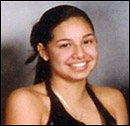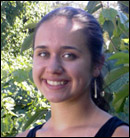It was a decidedly sober Whitney Houston who told us that the children are our future. And in the case of this year’s Brower Youth Award winners, she couldn’t be closer to the truth.
They are seven activists, aged 15 to 21, who represent varied backgrounds, communities, and missions. One young woman has battled environmental and social injustice in her town along the U.S.-Mexico border. Another has focused on restoring the wetlands in her community. A 15-year-old spreads awareness about the threatened sea turtles living off the Florida coast.
On Friday, Sept. 30, they will all be recognized for their hard work. The Brower Youth Awards, named in honor of venerable activist David Brower and presented every year since 2000, spotlight young people leading tomorrow’s environmental and social-justice movements today.
This year’s winners told Grist their stories, and shared their hopes for the future of environmental activism.

Jessica Rimington.
Photo: Earth Island Institute.
Jessica Rimington, 19, Cotuit, Mass.
“I founded a global sister-school initiative called One World Youth Project, which connects middle and high schools in the U.S. with schools from around the world. They work together in learning partnerships that emphasize cultural exchange, youth leadership, and community service. The youth also work directly with their sister school on the Millennium Development Goals, addressing such issues as environmental sustainability and the eradication of poverty. Last year, 20 schools participated from 11 countries and seven U.S. states. This year, 36 schools will be participating from 16 countries.
“I see the future of the environmental movement being increasingly tied to social-justice issues and perhaps soon being deemed a ‘sustainability movement.’ I think widespread change concerning these topics is possible and absolutely necessary. Awareness is growing; communication is becoming easier and quicker. NGOs are more effectively organizing and planning.
“I hope to help bridge the gap between awareness and effective, sustainable action. I am particularly passionate about the idea of a ‘global partnership for development’ — cross-cultural communication that leads to collaborative and tangible action, but not just through the lens of charity. I also think there needs to be a greater link between academia and activism. I am not sure what my role would be, but I could see myself working through NGOs or going into public service.”

Zander Srodes.
Photo: Earth Island Institute.
Zander Srodes, 15, Placidia, Fla.
“When I was 11, I applied for a local youth grant. With that money, I started going to schools, libraries, and special events, speaking to kids and adults about sea-turtle conservation, because the sea turtles that nest along the beaches on the west coast of Florida are extremely threatened.
“I do a PowerPoint presentation and have a young person put on a turtle costume I made. I also have a biodegradability chart explaining how long trash takes to break down in the ocean. I bring a sandbox and have kids bury a Ping-Pong ball in the sand, just like a mother turtle would do to make her nest on the beach. The newest addition to my presentation is an activity book I recently wrote. I raised money through grants to pay for the printing.
“My thought on the future of the environmental movement is that it will take more environmentally sensitive politicians in order to make a difference and have long-range effects on protecting our natural resources.
“The role that I intend to play in the future is either as an environmental lawyer or a politician.”

Andrea Garza.
Photo: Earth Island Institute.
Andrea Garza, 21, Albuquerque, N.M.
“As a very young person growing up in the border town of Brownsville, Texas, I witnessed the social, economic, and environmental degradation that takes place in many border communities. Determined to give my peers an alternative to ignorance, I founded the youth group Esperanza Unida, which is dedicated to utilizing the strength, culture, and tradition of our ancestors to protect and educate against injustice in the community.
“Esperanza Unida began its political activism by protesting a proposed nuclear waste facility in the state, which — after much lobbying and vocal opposition by several groups — was defeated. It also focused on educating students about their roots, culture, and traditions. Now, living in Albuquerque, I am a community organizer for Young Women United, a group started by and for young women of color.
“I would like to see more consciousness among young people and the public in general — everybody needs to be educated on what is going on with our environment. I’d like to see an environmental movement that is more accessible to low-income people of color. Why is it that some people can shop at health-food stores and buy organic bananas at $2.79 a pound, while a poor mother of four has to shop at Wal-Mart, where bananas sprayed with chemicals are 59 cents a pound? We are forced to pollute our bodies with the food that we eat and the water that we drink.
“I would also like to see an environmental movement that is more accessible, more fairly funded, and accountable to all communities. I will raise my two-year-old son to love and respect our Mother Earth and all of her resources. I will continue to educate communities and young people about all the environmental injustices and how it is our responsibility and obligation to challenge and fight those injustices.”

LaConstance Shahid.
Photo: Earth Island Institute.
LaConstance Shahid, 18, San Francisco, Calif.
“The project I am involved in is the Plants Gone Wild native-plant nursery run by Literacy for Environmental Justice. We, the youth of the project, grow native Californian plants for the Yosemite Slough Wetland Restoration [in Candlestick Park, San Francisco]. This project will help restore our community’s wetlands, helping improve some of the bad air and water quality in the community of Bayview-Hunters Point.
“I see the environmental movement growing larger. From what I see, there are a lot of people already involved and more people joining in this movement.
“I have dreams of becoming an author, but I see myself staying involved in the environmental movement. Working at Literacy for Environmental Justice and on this project has gotten me interested in what I’m doing, and I will stay involved.”

Erika Chase.
Photo: Earth Island Institute.
Erika Chase and Kayla Carpenter, 17, Hoopa, Calif.
“Kayla is a Yurok tribal member, and I am a Hoopa Valley tribal member, so culture is definitely an important component in both of our lives, and one of the main things that gives us our drive. In 2003, we started an annual 39-mile Salmon Relay Run, which has contributed to our communities’ efforts to promote awareness about our local water and fish issues. In light of the catastrophic fish kill in the lower Klamath basin [in 2002] that claimed the lives of over 64,000 salmon, we realized that something had to be done, because if such problems continue to happen, a major part of our cultural lifestyle could potentially become only a memory.

Kayla Carpenter.
Photo: Earth Island Institute.
“On a personal level, our environment has always been a priority in the minds of my people; therefore, I have established the philosophy that it is the youth of my generation who must take on this responsibility of ensuring the future.
“As the need for people to fight for the good of the environment grows, I feel that I will definitely be involved. Native people are constantly dealing with environmental rights of entitlement. One of my goals is to become a tribal-rights attorney to ensure that our indigenous lands and environment will be taken care of and protected.”
Daniel Rosen, 19, Flagstaff, Ariz.
“I helped organize the All Peoples Power Summit, held last year. The summit was a chance to bring together youth from across the country who are working to build communities that challenge the structures of exploitation and domination while cultivating hope, strength, and sustainability. The Youth Movement, an organization I helped found this year, has eight community-based projects that provide badly needed outlets for youth to create social change, from an artists’ network to courses that fill the gaps of the education system.

Daniel Rosen.
Photo: Earth Island Institute.
“At the rate things are going, it is possible that in five to 10 years, youth will be the face of the ‘environmental movement.’ We envision a movement without the bureaucracy, without the full-time desk jobs. I see youth building gardens, installing renewable energy, stopping corporate giants, and basically — although it sounds cliché — taking it to the streets. In other words, a movement that has many movements within it. A movement that is ingrained in everything we do — something that we cannot separate from who we are.
“I see myself developing community projects that are going to take us to that next level of consciousness and way of life. I don’t like to think of myself as an organizer. I really don’t like that word. It’s about our families, our communities, and ourselves — being balanced mentally, physically, and spiritually. It’s about responsibility. I see this work allowing me, in 10 years, to have a family in the context of a strong community, one that is environmentally, culturally, and spiritually sustainable.”


